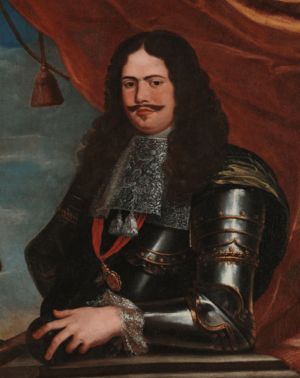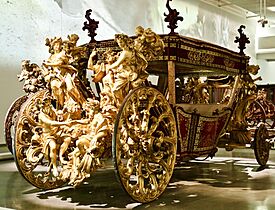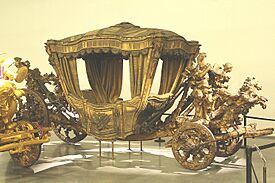Rodrigo Anes de Sá Almeida e Meneses, 1st Marquis of Abrantes facts for kids
Quick facts for kids
The Marquis of Abrantes
|
|
|---|---|
 |
|
| Portuguese Ambassador to the Holy See | |
| In office 1712–1718 |
|
| Monarch | John V of Portugal |
| Preceded by | André de Melo e Castro |
| Succeeded by | The Count of Galveias |
| Portuguese Ambassador to Spain | |
| In office 1727–1729 |
|
| Monarch | John V of Portugal |
| Preceded by | José da Cunha Brochado |
| Succeeded by | Manuel Ribeiro |
| Personal details | |
| Born |
Rodrigo Anes de Sá Almeida e Meneses
19 October 1676 Lisbon, Portugal |
| Died | 30 April 1733 (aged 56) Abrantes, Portugal |
Rodrigo Anes de Sá Almeida e Meneses (born October 19, 1676 – died April 30, 1733) was an important Portuguese nobleman and diplomat. He was known as the 1st Marquis of Abrantes. Before 1718, he held the titles of 3rd Marquis of Fontes and 7th Count of Penaguião.
The Marquis of Abrantes became well-known internationally in the early 1700s. He served King Peter II and later his son, King John V. As an ambassador, he played a big part in two important events. These were the special trip to Pope Clement XI in 1716 and the Exchange of the Princesses in 1729.
Early Life and Family
Rodrigo was the third and youngest son of D. Francisco de Sá e Meneses. His mother was D. Joana Luísa de Lancastre. His uncle, D. Luís de Sousa, who was a Cardinal-Archbishop, baptized him. After his father died in 1677, his mother took charge of his education. She wanted Rodrigo to study writing and books. So, she hired a famous Latin teacher named Inácio da Silva for him.
His mother's plans changed when Rodrigo's two older brothers died. In 1688, at age 12, Rodrigo became the head of his powerful family. In 1690, his mother arranged for him to marry D. Isabel Henriqueta de Lorena. She was the daughter of the Duke of Cadaval. They had four children together. Sadly, D. Isabel became ill and died on November 26, 1699.
After his wife passed away, the Marquis of Fontes began working more directly for the King. During the War of the Spanish Succession, Portugal joined with England and Germany. They wanted to stop France and Spain from uniting under one ruler. The Marquis of Fontes served as a military leader. He commanded a group of soldiers from 1703 to 1706. He paid for new military uniforms for his men. He also made sure they were well-fed. He often stayed in monasteries and gave them money.
Grand Embassy to Pope Clement XI
The Marquis of Fontes was chosen to be a special ambassador for John V of Portugal to the Holy See (the Pope's government). His family had a long history of diplomatic service. This was a very important job. King John V's reign was known for its rich culture and art. It showed Portugal as a powerful empire and the King as a supporter of arts and sciences.
The Marquis left for Genoa on January 9, 1712. He traveled on a ship with his family and friends. The journey was rough, especially when crossing the Gulf of Lion. They had to land in Cagliari, Sardinia, for a short time. They arrived in Rome on May 21, 1712. The next day, they attended a special mass. The Marquis first stayed with another Portuguese envoy. Later, he rented a house in Piazza Colonna.
The Marquis's official public entry into Rome was delayed for four years. This was because of a long waiting list for such events. He used this time to carefully plan a very grand ceremony. During this period, he became good friends with Cardinal Annibale Albani. The Cardinal was Pope Clement XI's nephew. The Marquis gave the Cardinal many valuable gifts. These included items from Brazil and India, and Chinese and Japanese porcelain. These gifts showed how vast and important the Portuguese Empire was.
The Marquis of Fontes made his public entrance in Rome on July 8, 1716. It was an unusually splendid parade. All the rules of diplomatic etiquette were followed carefully. The procession included five special state coaches. Three of these coaches are still kept in the National Coach Museum in Lisbon. There were also 10 other vehicles. The total number was more than the 12 officially required.
The carriages were richly decorated with large golden sculptures. These decorations celebrated Portugal's victories overseas. They showed how Portugal spread the Roman Catholic faith. They also showed off Portugal's wealth. Most importantly, they told the Pope and other ambassadors that Portugal was an old imperial power. Its lands were gained before other European countries became colonial powers. By showing off Portugal's achievements in the Indian Ocean, the Embassy was a great success. It helped change the idea that Portugal's lands in India were in decline. It presented Portugal as a strong empire.
It is believed that the Marquis of Fontes himself was very involved in designing the decorations for the carriages.
After the parade, Pope Clement XI showed great kindness and joy to the Marquis. The ambassador then formally presented his official letter. He told the Pope about the birth of a new Portuguese prince, Carlos. He also explained that King John was sending help to defend Italy. Italy was being threatened by the Ottoman forces.
The Embassy of the Marquis of Fontes was a huge success. He impressed the papal court. As a result, Pope Clement XI raised the status of the Archdiocese of Lisbon. It became the Patriarchate of Lisbon. This made Lisbon one of only two cities in Europe with this special title, the other being Venice. King John's good relationship with the Pope continued. In 1717, Portuguese ships helped win the Battle of Matapan. This battle was part of the ongoing war between the Ottomans and Venice.
Later Life and Achievements

When he returned to Lisbon, King John V gave D. Rodrigo Anes de Sá a new title. On June 24, 1718, he became the Marquis of Abrantes. This title also gave him the special privilege of being considered "Kin to the King." This meant he was officially recognized as related to the royal family. This gave him a higher rank than other noblemen. The name "Abrantes" was chosen because he was a descendant of the old Counts of Abrantes.
From 1727 to 1729, the Marquis of Fontes also served as a special ambassador to the Spanish Court. There, he was in charge of talks for the "Exchange of the Princesses." This was a double marriage agreement. Spanish Princess Mariana Victoria of Spain married the Portuguese heir, Joseph, Prince of Brazil. Her older half-brother, Ferdinand, Prince of Asturias, married Joseph's sister, Princess Barbara of Portugal. This event happened in January 1729. After this, the King of Spain gave him the Order of the Golden Fleece, a very high honor.
He died on April 30, 1733. His only son, D. Joaquim Francisco de Sá Almeida e Meneses, inherited his titles.




